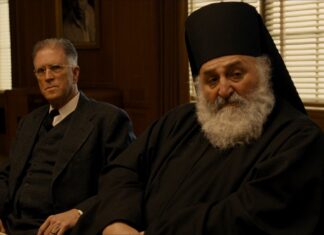PALISADES PARK, N.J. — Some 130 children and adults crowded into the hall of the Armenian-American Support and Education Center on June 11 to see an Armenian-language puppet show, “Ughdin Hayrenike” [The Camel’s Homeland], performed by children. The show was organized by Vartan Garniki’s Hye Theater Studio.
Seven young Armenians performed with their puppets a dramatized Western-Armenian version of a short story by Sergey Vardanian of Yerevan. Vardanian originally published a set of children’s short stories in Yerevan in 1989 called Arevadzaghig [Sunflower], which was translated by Makruhi Hagopian and published in Western Armenian in Istanbul in 1994. Vardanian, today working at the Archaeology and Ethnology Institute of the Armenian Academy of Sciences, worked for many years as a journalist and also served from 1991 to 2002 as the vice president of the State Council on Religious Affairs of the Republic of Armenia. He has organized a movement to collect folkloric materials in Armenian schools in Armenia, Georgia, Azerbaijan, Mountainous Karabagh, Nakhichevan, Abkhazia and Krasnodar (Russia), which were published in two volumes in 1981 and 2003. He has published a volume on the twelve historical capitals of Armenia, first in 1985, and then in an enlarged edition in 1995, and is a specialist on the Hamshen Armenians of Central Asia and founding editor of the monthly Dzayn Hamshenakan [Hamshen Voice].
The plot of the play concerns a camel that sets off to find his homeland and convinces other animals he meets along the way to join him. When they arrive in the desert, the other animals realize that this may be an ideal home for the camel but it is too hot and in general unsuitable for them. They then return to their original homes with renewed appreciation of their own value. The story can be taken as a parable for Armenians scattered throughout the world.
Naturally, a show performed by children may not be perfect in all aspects of its presentation, but in this particular instance, it was appropriate for the children in the audience, who seemed to enjoy it greatly. My own two boys eagerly asked when the next performance would take place. Such plays should be constants in the arsenal of tools to make Western Armenian relevant to children. Several children apparently afterwards expressed an interest in participating in future performances.
The positive effects of the play were not limited to the children in the audience. Director Vartan Garniki told the audience that some of the children in the play, who are of varying ages, did not know much Armenian when they began their rehearsals. In fact, one boy could only recite his lines and did not understand any Armenian at all.
Garniki has organized similar plays for children for the Khrimian Lyceum of the Diocese of the Armenian Church of America (Eastern). He established Hye Theater Studio in 2006 and its first performance, “Honest Person,” was performed by children and based on four tales by Hovhannes Toumanian. Hye Theater Studio has also presented two plays for adults in Armenian.








